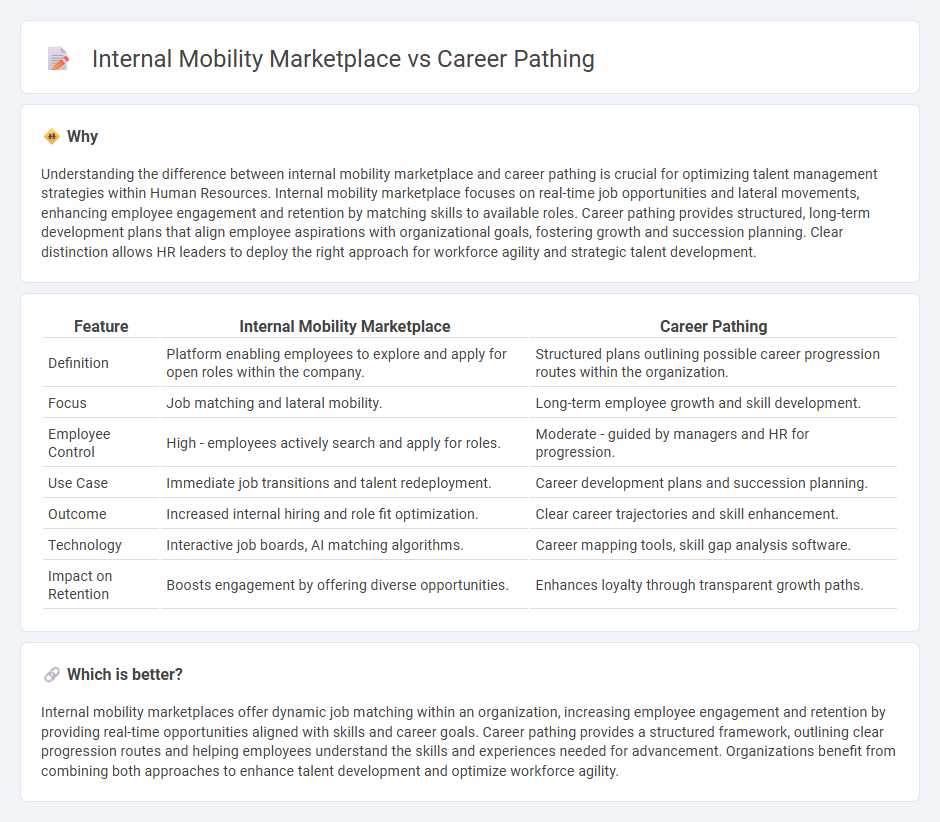
Internal mobility marketplaces enable employees to explore diverse roles across the organization through a transparent platform, fostering skill development and retention. Career pathing focuses on structured progression within specific job families or departments, aligning employee growth with organizational goals. Discover how combining these strategies can optimize workforce agility and talent management.
Why it is important
Understanding the difference between internal mobility marketplace and career pathing is crucial for optimizing talent management strategies within Human Resources. Internal mobility marketplace focuses on real-time job opportunities and lateral movements, enhancing employee engagement and retention by matching skills to available roles. Career pathing provides structured, long-term development plans that align employee aspirations with organizational goals, fostering growth and succession planning. Clear distinction allows HR leaders to deploy the right approach for workforce agility and strategic talent development.
Comparison Table
| Feature | Internal Mobility Marketplace | Career Pathing |
|---|---|---|
| Definition | Platform enabling employees to explore and apply for open roles within the company. | Structured plans outlining possible career progression routes within the organization. |
| Focus | Job matching and lateral mobility. | Long-term employee growth and skill development. |
| Employee Control | High - employees actively search and apply for roles. | Moderate - guided by managers and HR for progression. |
| Use Case | Immediate job transitions and talent redeployment. | Career development plans and succession planning. |
| Outcome | Increased internal hiring and role fit optimization. | Clear career trajectories and skill enhancement. |
| Technology | Interactive job boards, AI matching algorithms. | Career mapping tools, skill gap analysis software. |
| Impact on Retention | Boosts engagement by offering diverse opportunities. | Enhances loyalty through transparent growth paths. |
Which is better?
Internal mobility marketplaces offer dynamic job matching within an organization, increasing employee engagement and retention by providing real-time opportunities aligned with skills and career goals. Career pathing provides a structured framework, outlining clear progression routes and helping employees understand the skills and experiences needed for advancement. Organizations benefit from combining both approaches to enhance talent development and optimize workforce agility.
Connection
Internal mobility marketplaces facilitate career pathing by providing employees with transparent access to available roles and skill development opportunities within the organization. These platforms enable real-time tracking of competencies, allowing HR to align individual career goals with business needs effectively. Integrating internal mobility with career pathing enhances employee retention, engagement, and talent utilization.
Key Terms
**Career Pathing:**
Career pathing involves strategically mapping out an employee's progression within an organization by identifying skills, experiences, and roles required for advancement, fostering long-term professional growth and retention. It emphasizes personalized development plans and clear milestones aligned with organizational goals, promoting employee engagement and talent optimization. Explore how career pathing can transform your workforce development strategy for sustainable success.
Succession Planning
Career pathing establishes a structured framework for employee development aligned with long-term succession planning by identifying skills gaps and aligning individual goals with organizational needs. An internal mobility marketplace accelerates succession planning through dynamic job matching based on real-time talent availability and personalized growth opportunities, thereby enhancing leadership pipeline readiness. Explore how integrating career pathing and internal mobility marketplaces can optimize your succession planning strategy for sustained organizational growth.
Skill Gap Analysis
Skill gap analysis plays a crucial role in both career pathing and internal mobility marketplace by identifying employees' current competencies compared to job requirements. Career pathing uses this analysis to create personalized development plans that guide employees toward targeted roles within the organization. Explore how leveraging skill gap analysis can enhance workforce planning and talent optimization.
Source and External Links
What Is Career Pathing & Why Is It Important? - Career pathing is the process employers use to create a personalized development plan for employees, aligning their skills and interests with career objectives.
Career Pathing: The Complete Guide - This guide explores two main approaches to career pathing: the traditional career ladder and the career lattice, which offers more flexibility in career progression.
Improve Employee Development with Career Pathing - Career pathing involves mapping an employee's potential trajectory at a company, typically including self-assessment, individualized career mapping, and exploring opportunities.
 dowidth.com
dowidth.com